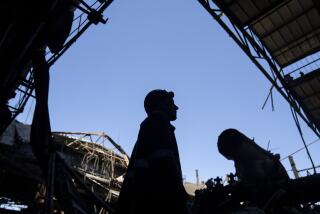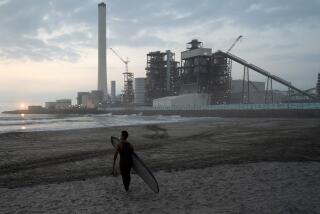Key Lesson of Chernobyl Has Been Lost
- Share via
The two-hour van ride from the Kiev train station to the Chernobyl nuclear power plant took us through numerous checkpoints in a desolate countryside where 136,000 people had been evacuated. Eerie is the only word that can properly embrace the loneliness of deserted hamlets and farms where humans were afraid to live. Clothing still hung on the lines uncollected almost a year after the disaster.
Finally, at the nuclear power plant gate, after being outfitted with outer garments to ward off radiation and Geiger counters to measure it, I experienced the dubious distinction of being the first U.S. newspaper reporter permitted to visit the control room and turbines of the plant adjacent to the one that had suffered a meltdown on April 26, 1986. That’s the same plant that reopened last week despite Western objections that it is not Y2K ready, a charge that does give one pause.
What made that occasion of my visit 11 months after the disaster so terrifying was the prevalence of confusion and fear about the enduring consequences of the worst nuclear accident the world has witnessed. The toll from the radiation that spewed over neighboring countries is not yet complete. But cancer rates are up, babies are routinely born deformed, and half a million heavily irradiated acres in neighboring Belarus remain off limits to humans.
The 1986 disaster occurred in one of four Chernobyl reactors, and the smoldering, forever-deadly ruin was hurriedly encased in a sarcophagus of concrete and steel. Now that sarcophagus is old, cracking and possibly leaking. Repairs are planned, but Ukraine, which is now an independent but poor country, has been slow to make them because it’s short of cash. For money reasons, the country justifies reopening the one surviving reactor, after five months of repairs, until $1.1 billion is supplied by the West for a new nuclear plant.
The U.S. State Department warns that Ukraine “appears to be unprepared” to deal with the Y2K bug for its computer-run nuclear plants. The department said there is “a risk of potential disruption in all key sectors, especially the energy and electric services.” That’s ominous because the meltdown at Chernobyl was caused by disruption when engineers shut down the operation abruptly to conduct safety experiments. Any sudden interruption of power to the remaining nuclear plant in Chernobyl--or elsewhere--because of a Y2K computer glitch might produce horrible results.
Ukraine is a bitterly cold place in winter, and it is no small matter that 40% of its electricity comes from aging nuclear power plants. A deal needs to be cut between the rich West and the Ukrainian government to make the Chernobyl plant safe by Jan. 1.
But the inherent risks of nuclear power pales in comparison to the much more serious threat of nuclear weapons, which are designed to wreak maximum havoc. And remember, the 3,000 missile warheads in Russia that are cocked for imminent firing are aimed at us. They, too, might experience a Y2K problem.
As potentially dangerous as nuclear power plants are, they, at least, are designed for peaceful use. Perhaps it’s helpful that arrangements have been made for Russian military experts to be sitting in a room at the air defenses command in Colorado as the New Year’s ball falls to reassure their colleagues back home that blips that might appear on their radar screens do not represent U.S. missile launches. But that we and the Russians have made so little progress in getting rid of nuclear weapons in the 10 years since the end of the Cold War is a scandal.
At the time, Chernobyl was a stunning reminder of the nuclear threat. In the old Soviet Union, it put a stop to the dangerous belief of some in civil defense and civilization’s ability to survive a nuclear war. “It didn’t change my thinking about civil defense because I never believed in it,” said Yevgeny Velikhov, the nuclear physicist who oversaw containment of the Chernobyl meltdown, “but it opened the eyes of all people that civil defense is nonsense.”
Within hours after the meltdown, Velikhov flew in a helicopter over the plant as it belched its radiation, risking his own life to survey the damage. “With Chernobyl, we were able to mobilize the resources of the entire country,” he told me, “but a nuclear war involves many more frightening incidents, including the more devastating effects of blast and heat. So what could you do? Nothing.”
That key lesson of Chernobyl has been lost. Hopefully a Y2K disaster will not bring it to the fore.
More to Read
Sign up for Essential California
The most important California stories and recommendations in your inbox every morning.
You may occasionally receive promotional content from the Los Angeles Times.










